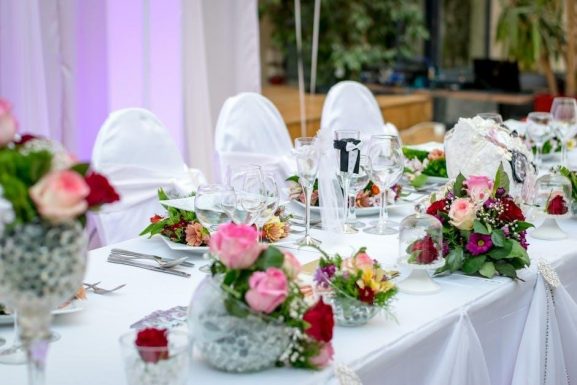A wedding reception checklist ensures smooth execution‚ covering essentials like timelines‚ vendor coordination‚ and budgeting. It helps maintain organization‚ reduces stress‚ and guarantees a memorable event.
1.1 Importance of a Checklist
A wedding reception checklist is essential for ensuring every detail is meticulously planned and executed. It provides a structured approach to managing tasks‚ from vendor coordination to decor setup‚ while maintaining a clear timeline. By prioritizing tasks and tracking progress‚ a checklist minimizes stress and ensures accountability. It also helps couples stay within budget and focus on creating a memorable experience for themselves and their guests‚ making it an indispensable tool for a flawless celebration.
1.2 Setting Clear Goals for Your Reception
Defining clear goals for your wedding reception ensures alignment with your vision‚ priorities‚ and expectations. Consider the number of guests‚ budget‚ and personal style to shape your objectives. Goals may include selecting a venue‚ finalizing catering‚ or achieving a specific decor theme. Clarity in these areas helps guide decision-making and resource allocation‚ ensuring a cohesive and memorable celebration that reflects your preferences and creates a joyful experience for you and your guests.

Choosing the Perfect Wedding Reception Venue
Selecting the ideal venue involves considering location‚ accessibility‚ capacity‚ and amenities. Ensure it aligns with your budget and vision for a seamless and memorable celebration.
2.1 Location and Accessibility
Choose a venue with a convenient location‚ ensuring easy access for all guests; Consider proximity to accommodations for out-of-town attendees and availability of parking. Opt for a central spot to minimize travel logistics. Ensure the venue is wheelchair accessible and has necessary facilities for guests with disabilities. A well-connected location enhances guest experience and attendance rates‚ making your celebration more enjoyable and stress-free for everyone involved.
2.2 Capacity and Space Requirements
Ensure the venue can comfortably accommodate your guest count‚ with ample space for seating‚ dining‚ and mingling. Consider both seated and standing capacities to meet your reception needs. Verify the venue’s maximum capacity and ensure it aligns with your guest list. Check for a dedicated dance floor and additional areas for photo booths‚ bars‚ or buffet stations. Adequate space ensures a relaxed atmosphere‚ preventing overcrowding and enhancing the overall experience for you and your guests.
2.3 Venue Amenities and Services
Ensure the venue offers essential amenities like catering services‚ restrooms‚ and adequate lighting. Check for in-house decor support‚ tables‚ chairs‚ and linens. Verify availability of audiovisual equipment and power sources for entertainment. Parking‚ accessibility‚ and cloakroom facilities are crucial for guest comfort. Some venues provide event coordination services‚ which can simplify planning. Confirm if vendors can access the space easily for setup. Ensure all amenities align with your vision and guest needs for a seamless experience.
2.4 Budget Considerations
Define your budget limits and prioritize spending based on what matters most. Allocate funds to venue rental‚ catering‚ decor‚ and entertainment‚ ensuring alignment with your financial plan. Consider hidden costs like taxes‚ gratuities‚ and overtime fees. Compare packages from different venues to find the best value. Negotiate with vendors to stay within budget without compromising quality. Remember‚ thoughtful budgeting ensures a memorable reception while avoiding financial strain. Plan wisely to balance expenses and create an unforgettable celebration.
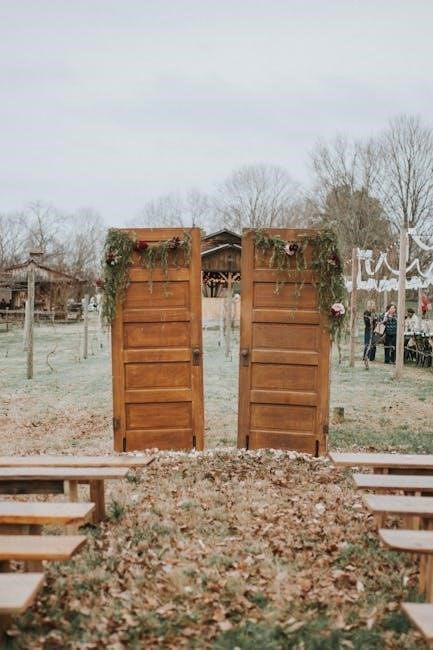
Creating a Detailed Budget for the Reception
Develop a comprehensive budget by categorizing expenses like venue‚ catering‚ decor‚ and entertainment. Track costs to ensure alignment with your financial plan and avoid overspending.
3;1 Allocating Funds to Different Aspects
Allocate funds to key areas such as venue‚ catering‚ decorations‚ and entertainment. Assign percentages based on priorities‚ ensuring no aspect is overlooked. Create a detailed breakdown to track expenses and make informed financial decisions. Use a checklist to categorize and manage allocations effectively‚ ensuring your budget aligns with your vision for the perfect reception.
3.2 Prioritizing Spending Based on Importance
Prioritize spending by identifying essential elements that matter most to you‚ such as food quality‚ venue ambiance‚ or entertainment. Allocate more funds to these areas while reducing costs on less critical aspects. Use your checklist to evaluate and adjust allocations‚ ensuring alignment with your vision and budget. This approach helps maximize impact and create a memorable experience without unnecessary expenses.
3.3 Tips for Saving Money Without Compromising Quality
To save money without sacrificing quality‚ consider off-season bookings‚ DIY decor‚ and flexible catering options. Opt for in-season flowers and simplify menus. Use digital invitations and repurpose ceremony decor for the reception. Negotiate with vendors for package deals and prioritize must-haves over nice-to-haves. These strategies help reduce costs while maintaining elegance and guest satisfaction.
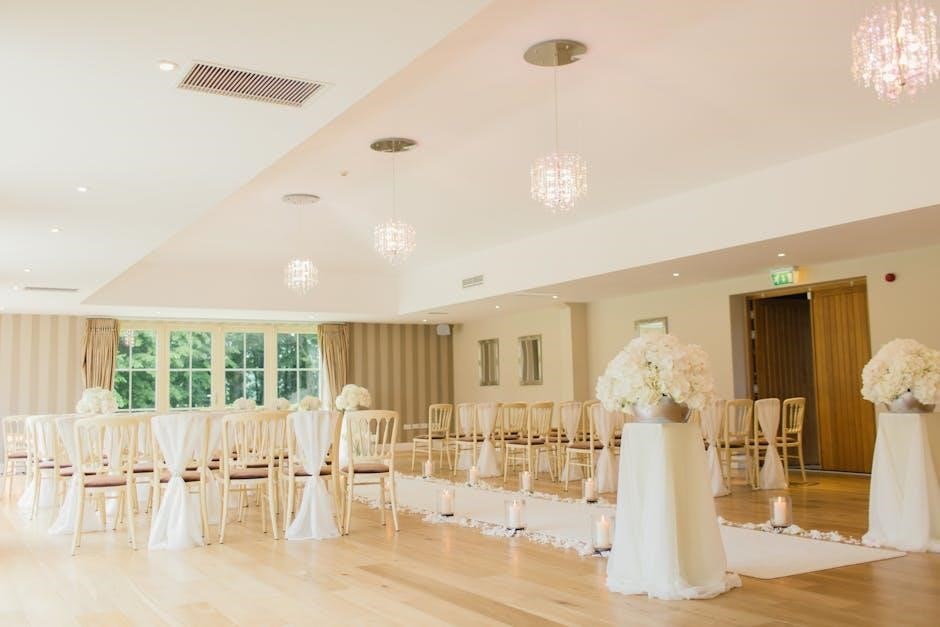
Managing Your Guest List
Finalizing the guest list ensures accurate headcounts for seating‚ catering‚ and invitations. Organize RSVPs efficiently and plan seating arrangements while addressing special requests or dietary restrictions.
4.1 Finalizing the Number of Guests
Finalizing the guest count is crucial for vendor coordination‚ budgeting‚ and space allocation. Create a detailed list‚ considering plus-ones and RSVP deadlines. Ensure accuracy to avoid overbooking or overcrowding. Review and confirm the list with your partner and vendors. Adjustments should be minimal once finalized. Consider sending reminders for RSVPs and prepare for last-minute changes. A finalized guest count ensures smooth planning and execution‚ aligning with your venue capacity and catering needs.
4.2 Organizing RSVPs and Confirmations
Organizing RSVPs and confirmations is essential for accurate headcounts. Send invitations with clear response deadlines and details. Use online tools or mail-in cards for convenience. Track responses meticulously and follow up with guests who haven’t replied. Confirm numbers with vendors and ensure all attendees are accounted for. Maintain a master list to cross-reference replies. Regular reminders and clear communication ensure everyone is informed and prepared. This step guarantees an accurate final count for catering‚ seating‚ and arrangements.
4.3 Seating Arrangements and Special Requests
Plan seating arrangements by creating a detailed floor chart‚ ensuring guests are grouped thoughtfully. Consider special requests like dietary restrictions‚ accessibility needs‚ or table preferences. Use place cards or digital tools to visualize and finalize seating. Communicate clearly with guests about their requirements and confirm with vendors. Assign a point person to handle any last-minute adjustments. Ensure all special requests are documented and shared with the venue and catering team. A well-organized seating plan enhances guest comfort and overall event flow.
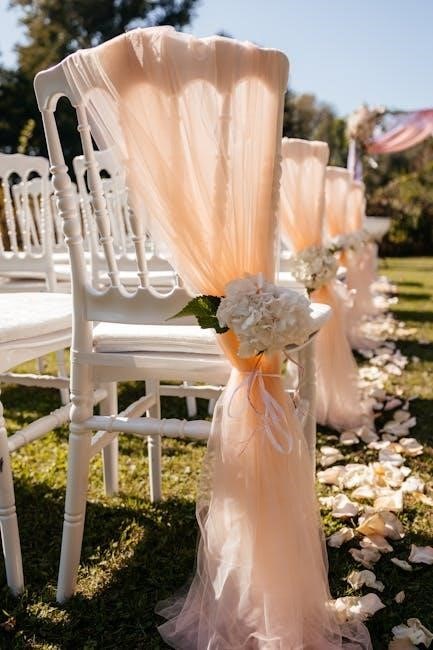
Planning the Decorations and Theme
A cohesive theme sets the tone for your wedding reception‚ guiding decor choices like centerpieces‚ lighting‚ and floral arrangements. Ensure all elements align for a polished look.
5.1 Selecting a Cohesive Theme
Selecting a cohesive theme is crucial for a visually appealing wedding reception. Popular themes include vintage‚ rustic‚ or modern designs. Ensure the theme reflects your personality and style. Consider elements like floral arrangements‚ lighting‚ and stationery to maintain consistency. A well-chosen theme ties together decor‚ attire‚ and ambiance‚ creating a memorable experience for guests. Use a checklist to track theme-related decisions and ensure all details align seamlessly. This step sets the foundation for a harmonious and impactful celebration.
5.2 Essential Decor Items for the Reception
Essential decor items for the reception include centerpieces‚ floral arrangements‚ and lighting. Table settings like linens‚ napkins‚ and chinaware are also vital. Add decorative elements such as candles‚ lanterns‚ or fairy lights to enhance ambiance. Signage‚ like welcome signs or seating charts‚ provides direction and personalization. Ensure all items align with your chosen theme. Use a checklist to track decor rentals or purchases‚ and confirm delivery or setup details with vendors. These elements create a cohesive and memorable atmosphere for your celebration.
5.3 DIY vs. Professional Decor Options
Deciding between DIY and professional decor options depends on your budget‚ time‚ and desired aesthetic. DIY decor offers cost savings and personalization but requires effort and creativity. Professional services provide expertise and convenience‚ ensuring polished results. Consider your skills‚ available time‚ and resources. For DIY‚ plan materials and setup in advance. For professionals‚ review contracts and portfolios. Both options can create stunning decor‚ so choose based on your priorities and wedding style. Balance creativity with practicality for the best outcome.

Organizing Entertainment and Activities
Hire a DJ or live band for music‚ and consider photo booths or games for guest engagement. Ensure setup includes a dance floor and adequate power sources to create a lively atmosphere.
6.1 Hiring a DJ or Live Band
Hiring a DJ or live band sets the tone for your reception. Discuss playlists‚ genres‚ and pacing to match your vision. Ensure the venue has adequate power and space for equipment. A live band offers a dynamic energy‚ while a DJ provides versatility and cost-effectiveness. Schedule a soundcheck to avoid technical issues. Clear communication ensures seamless transitions between speeches‚ toasts‚ and dancing. This entertainment choice will keep guests engaged and create lasting memories.
6.2 Planning Speeches and Toasts
Organize speeches and toasts to ensure a smooth flow during the reception. Decide the order of speakers‚ such as the best man‚ maid of honor‚ and parents. Coordinate with the MC or planner to introduce each speaker. Provide guidelines for speakers to keep their messages heartfelt yet concise. Schedule key speeches between courses or during downtime to maintain guest engagement. Ensure audio equipment is tested beforehand for clarity; This planning creates meaningful moments and keeps the celebration on track.
6.3 Incorporating Fun Activities for Guests
Incorporate fun activities to keep guests entertained‚ such as photo booths with props‚ outdoor games‚ or sparklers for a magical touch. A dance floor encourages guests to let loose‚ while contests or group games add excitement. Timing these activities between courses or during downtime ensures a lively atmosphere. Organizing these elements creates lasting memories and keeps guests engaged throughout the celebration. A well-planned activity schedule enhances the overall experience‚ making your reception unforgettable for everyone involved.
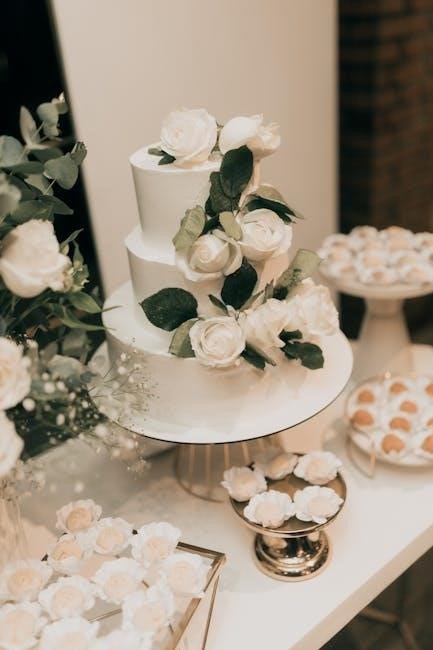
Coordinating the Reception Layout
Designing the floor plan ensures a seamless flow‚ with the dance floor centrally located and tables arranged for easy access. Adequate lighting enhances ambiance‚ while strategic placement of key elements like the photo booth and bar keeps guests engaged. A well-coordinated layout creates a welcoming and functional space‚ reflecting the wedding’s theme and style.
7.1 Designing the Floor Plan
Designing the floor plan involves strategically placing key elements like the dance floor‚ seating areas‚ DJ stage‚ photo booth‚ and bar to ensure smooth guest flow. A logical layout maximizes space‚ accessibility‚ and ambiance‚ reflecting the wedding’s theme. Ensure clear pathways for easy movement and accessibility to essential areas like restrooms and exits. Consider the placement of tables‚ aisles‚ and decorative elements to create a visually appealing and functional setup that aligns with your wedding style and guest experience goals.
7.2 Setting Up the Dance Floor
Setting up the dance floor involves choosing its size‚ type‚ and placement to encourage guest participation. Ensure the floor is sturdy‚ level‚ and suitable for dancing. Place it centrally for visibility and accessibility. Check for adequate power supply for lighting and sound equipment. Consider renting a professional dance floor if needed‚ and ensure it matches the wedding theme. Position speakers or DJ booths nearby to enhance the audio experience. Clear the area of obstacles to create a safe and inviting space for guests to enjoy.
7.3 Ensuring Adequate Lighting
Adequate lighting is crucial for creating the right ambiance at your wedding reception. Use a combination of ambient‚ task‚ and accent lighting to illuminate the space. Ensure the dance floor is well-lit for visibility and safety. Consider dimming options to adjust the mood throughout the event. Check power sources and backup lighting in case of outages. Outdoor events may require additional lighting solutions like string lights or lanterns. Test all lighting setups beforehand to ensure everything works perfectly.
Creating a Timeline for the Reception
A detailed timeline ensures your wedding reception runs smoothly‚ scheduling key events and transitions. Plan setup‚ guest arrival‚ speeches‚ and dancing‚ allowing ample time for each segment.
8.1 Establishing a Start and End Time
Set a clear start and end time for your reception to ensure smooth coordination. Consider guest arrival‚ ceremony duration‚ and venue availability. Share these timings with vendors and guests to avoid confusion. Allocate enough time for setup‚ dining‚ speeches‚ and dancing. Ending on schedule respects guest schedules and venue constraints‚ ensuring a seamless conclusion to your celebration.
8.2 Scheduling Key Events and Transitions
Scheduling key events ensures a seamless flow during your reception. Plan timelines for guest arrival‚ welcome cocktails‚ speeches‚ toasts‚ and the first dance. Include transitions like moving from dinner to dancing or cutting the cake. Clear timing helps vendors‚ entertainers‚ and guests stay aligned. Share this schedule with your wedding party and vendors to maintain coordination. Proper planning prevents lulls and keeps the celebration lively‚ ensuring every moment is enjoyed by all attendees.
8.3 Allocating Time for Setup and Breakdown
Allocate sufficient time for setup and breakdown to ensure a stress-free experience. Allow 2-3 hours for vendors to arrange decorations‚ tables‚ and equipment. Schedule setup before guest arrival to create a polished atmosphere. After the reception‚ plan 1-2 hours for breakdown‚ including removing decorations and securing belongings. Confirm these timings with vendors and the wedding party to ensure everything is in place and removed efficiently. A well-planned setup and breakdown prevent last-minute chaos and ensure a smooth event flow.
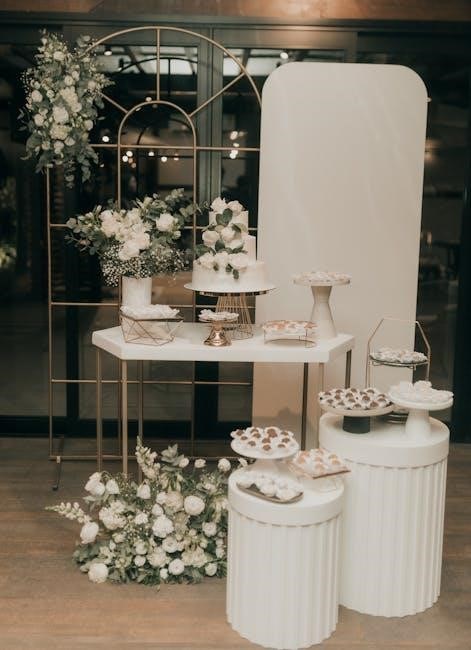
Planning the Food and Beverage Service
Plan the menu‚ select a caterer‚ and coordinate beverage services. Ensure dietary restrictions are met and schedule food and bar setup and service times efficiently.
9.1 Selecting a Catering Option
Selecting the right caterer is crucial for a memorable reception. Research and compare vendors‚ read reviews‚ and schedule tastings to ensure quality and flavor. Discuss menu options‚ dietary restrictions‚ and special requests. Consider buffet‚ plated‚ or family-style services based on your vision and budget; Ensure the caterer can accommodate your guest count and venue requirements. Finalize the contract with clear details on pricing‚ servings‚ and setup. This step ensures your wedding feast delights all attendees and aligns with your overall plan.
9.2 Designing the Menu
Designing the menu involves balancing flavors‚ dietary needs‚ and presentation. Consider your wedding theme and season for inspiration. Offer options for appetizers‚ mains‚ and desserts‚ ensuring variety. Include vegetarian‚ gluten-free‚ or vegan choices if needed; Pair dishes with appropriate beverages. Schedule a tasting to finalize selections and adjust flavors. Ensure the menu reflects your style and satisfies all guests. Finalize the menu well in advance to allow the caterer time to prepare and make necessary adjustments for a seamless dining experience.
9.3 Managing Bar and Beverage Services
Managing bar and beverage services involves deciding on the type of bar (open‚ cash‚ or limited)‚ selecting signature cocktails‚ wine‚ and beer options. Hire professional bartenders and ensure adequate supplies of glassware‚ ice‚ and mixers. Consider offering non-alcoholic alternatives for guests. Plan the timing for when the bar opens and closes‚ and coordinate with the catering team for seamless service. Ensure compliance with local liquor laws and arrange for proper setup and cleanup to maintain a smooth and enjoyable experience for all guests.
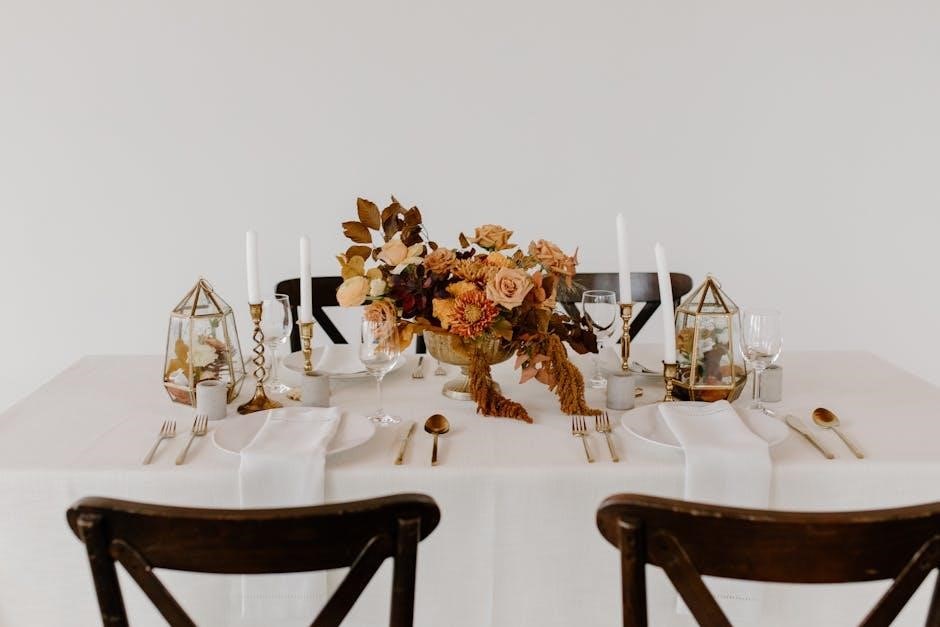
Organizing the Bridal Party Attire
Finalize dresses‚ suits‚ and accessories for the bridal party. Ensure fittings are scheduled and attire is ready for the wedding day. Coordinate hairstyles and makeup.
10.1 Finalizing Dresses and Suits
Ensure the bride’s dress and bridesmaids’ gowns are tailored and ready. The groom and groomsmen should have suits fitted and accessories like ties or boutonnieres prepared. Coordinate colors‚ fabrics‚ and styles for a cohesive look. Finalize footwear and jewelry to match the overall aesthetic. Schedule final fittings to confirm sizes and make any necessary adjustments. Ensure all attire is clean‚ pressed‚ and ready for the wedding day to avoid last-minute stress.
- Confirm dress and suit sizes with vendors.
- Plan for alterations if needed.
- Coordinate accessories for consistency.
10.2 Ensuring Accessories and Shoes
Accessories and footwear are crucial for completing the bridal party’s look. Ensure the bride’s jewelry‚ veil‚ and shoes match her dress. The groom and groomsmen should have cufflinks‚ ties‚ and polished shoes. Coordinate all items with the wedding theme and attire. Schedule final fittings to confirm styles and sizes. Check for missing items and ensure everything is clean and ready. Proper accessories enhance the overall aesthetic and create a cohesive‚ polished appearance for the wedding photos and ceremony.
- Confirm jewelry and footwear for the bride.
- Ensure groomsmen have matching accessories.
- Coordinate styles with the wedding theme.
10.3 Coordinating Hairstyles and Makeup
Hairstyles and makeup play a vital role in the bridal party’s overall look. Schedule trials to ensure styles align with the wedding theme. Confirm the makeup artist and hairstylist details‚ including arrival times and setups. Ensure the bride and bridesmaids have cohesive looks while allowing personal touches. Discuss preferences for natural or bold styles and review inspiration photos. Finalize all beauty arrangements to create a polished and memorable appearance for the wedding day.
- Schedule trials for hairstyles and makeup.
- Confirm stylist and artist arrival times.
- Review and finalize beauty looks collectively.
Sending Out Invitations and Stationery
Design and print invitations‚ ensuring all details are clear. Mail them 8-12 weeks before the wedding. Track RSVPs and prepare place cards for guests.
11.1 Designing and Printing Invitations
Start by selecting a design that matches your wedding theme. Include essential details like date‚ venue‚ time‚ dress code‚ and RSVP information. Choose high-quality paper and ink for printing. Consider DIY options or hire a professional designer. Ensure the design is cohesive with your wedding theme and reflects your personal style. Proofread for errors before printing. Include a link to your wedding website for guest convenience. Mail invitations 8-12 weeks prior to the wedding date. A well-designed invitation sets the tone for your celebration.
11.2 Mailing and Tracking RSVPs
Mail invitations with a pre-addressed‚ stamped RSVP card or include a link to an online response system. Track responses using a spreadsheet or digital tool. Set a clear deadline for RSVPs to ensure accurate headcounts. Follow up with guests who haven’t responded by the deadline. Consider sending reminders to simplify the process. Keep a record of confirmed attendees to share with vendors; This step ensures an accurate count for seating‚ catering‚ and favors‚ making the planning process seamless and stress-free.
11.3 Preparing Place Cards and Programs
Create personalized place cards with guests’ names and table assignments. Design wedding programs outlining the order of events‚ speeches‚ and key moments. Include meal options on place cards for caterers. Use a consistent design that matches your theme. Print and distribute programs at the entrance or with invitations. Ensure all details are finalized before printing to avoid errors. These elements enhance organization and provide guests with clear guidance‚ making the reception experience enjoyable and well-coordinated for everyone involved.
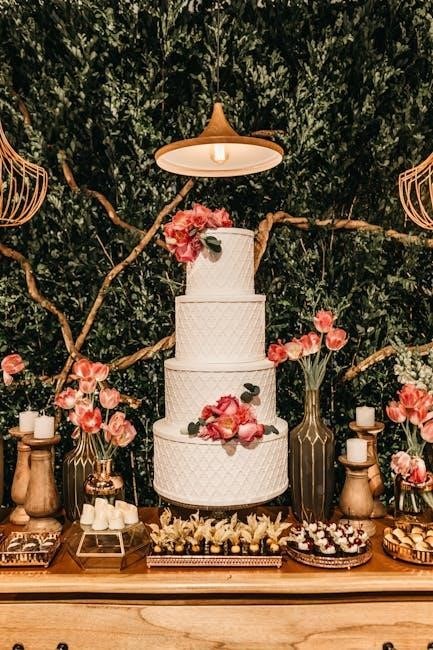
Addressing Legal and Administrative Tasks
Secure necessary permits‚ obtain marriage licenses‚ and ensure all vendor contracts are signed. Finalize insurance coverage and verify compliance with local regulations for a smooth‚ legally sound celebration.
12.1 Obtaining Necessary Permits
Ensure all required permits are secured for your wedding reception‚ including alcohol serving licenses and event permits. Check local regulations for specific requirements. Apply early to avoid delays‚ as processing times vary. Confirm fire and safety codes are met‚ especially for outdoor or unique venues. Gather all necessary documents‚ such as vendor permits and health department approvals. Keep copies of permits on hand during the event. Failure to obtain proper permits may result in fines or event cancellation‚ so thorough preparation is crucial.
